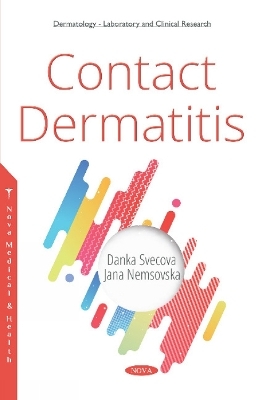
Contact Dermatitis
Seiten
2018
Nova Science Publishers Inc (Verlag)
978-1-5361-3485-8 (ISBN)
Nova Science Publishers Inc (Verlag)
978-1-5361-3485-8 (ISBN)
Contact dermatitis is a non-infectious inflammatory skin disease caused by an offending substance localized at the site of contact. The prevalence and incidence are increasing throughout the world, especially in Europe and North America. There are two main groups irritant contact dermatitis and allergic contact dermatitis with the former being more frequent. However, more than 4,000 contact allergens are known to cause allergic contact dermatitis in populations, of which nickel is the most common. Allergic contact dermatitis is a delayed IV type hypersensitivity resulting from cutaneous contact with a specific allergen. In pathogenesis, there is a significant difference between irritant and allergic dermatitis. Irritant contact dermatitis is a nonimmunologic, nonspecific inflammatory reaction to a wide range of chemical, physical or mechanical hazardous causes involving the innate immune system without prior sensitization. On the other hand, in a delayed type of hypersensitivity, concomitant activation of both the innate and adaptive immune systems is required. Recent studies disclose the role of TH17 in the pathogenesis of allergic contact dermatitis. Despite a distinct pathogenesis of both irritant and allergic contact dermatitis, there is no absolute visual distinction between both types of contact dermatitis. In general, irritant contact dermatitis tends to be milder than its allergic counterpart. Patch testing is a standardized diagnostic procedure used to confirm the causative allergen. The most common technique is an occlusive patch test, but in exceptional circumstances a modification of the patch test such as a photopatch test, open test, repeated open application test (ROAT), strip patch test or atopic patch test is used. Irritant contact dermatitis does not possess special testing. The diagnosis is therefore established by exclusion of negative test results in patch testing. Patch test may also be performed in infants and children, whereby the indications and testing technique are the same as in adults. In the management of contact dermatitis, the keystone is to cease causal exposure, meaning avoiding contact with the offending substance. In topical therapy, the choice of active substance is important, but a suitable vehicle disposes transportation to the site of inflammation. Selection of the vehicle depends on the clinical appearance and course of disease. The choice of an unsuitable vehicle may result in the drop-out of topical therapy. Topical corticosteroids are the mainstay therapy. Calcineurin inhibitors are employed in dermatology as an alternative therapy to topical corticosteroids with a better safety profile. Systemic treatments are used in severe cases and may provide temporary remission, but are not always suitable for prolonged use due to adverse effects. Alitretinoin is used to treat severe and refractory chronic hand dermatitis. After clinical clearance of contact dermatitis, the skin barrier requires restoration therapy provided by a moisturizing agent, which should be used for a prolonged period. The application of a moisturizing agent promotes epidermal barrier healing, prolongs the time to flare and reduces the number of flares. Most frequently, absolute avoidance of the triggering offending contact is very difficult, or even impossible. Therefore, protective measures to prevent renewed skin contact are indicated. Any type of symptomatic treatment cannot substitute this approach.
Faculty of Medicine, Comenius University, Bratislava, Slovakia
For more information, please visit our website at:Hardcover: https://www.novapublishers.com/catalog/product_info.php?products_id=64395E-book: https://www.novapublishers.com/catalog/product_info.php?products_id=64396
| Erscheinungsdatum | 29.08.2018 |
|---|---|
| Verlagsort | New York |
| Sprache | englisch |
| Maße | 155 x 230 mm |
| Gewicht | 236 g |
| Themenwelt | Medizin / Pharmazie ► Medizinische Fachgebiete ► Dermatologie |
| ISBN-10 | 1-5361-3485-6 / 1536134856 |
| ISBN-13 | 978-1-5361-3485-8 / 9781536134858 |
| Zustand | Neuware |
| Haben Sie eine Frage zum Produkt? |
Mehr entdecken
aus dem Bereich
aus dem Bereich
Differentialdiagnostik und Therapie bei Kindern und Jugendlichen
Buch (2022)
Thieme (Verlag)
CHF 191,00
Allergene - Diagnostik - Therapie
Buch (2022)
Thieme (Verlag)
CHF 249,00
richtig verschreiben – individuell therapieren
Buch (2023)
Thieme (Verlag)
CHF 99,40


